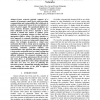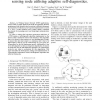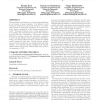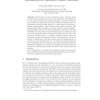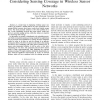DSD
2006
IEEE
14 years 5 months ago
2006
IEEE
Wireless sensor networks (WSN) are composed of battery-driven communication entities performing multiple, usually different tasks. In order to complete a given task, all sensor no...
COMSWARE
2006
IEEE
14 years 5 months ago
2006
IEEE
Sensor networks typically comprise of a number of inexpensive small devices with processing, communication and sensing abilities that collaborate to perform a common task. Sensor d...
PERVASIVE
2007
Springer
14 years 5 months ago
2007
Springer
We propose a method through which dynamic sensor nodes determine that they move together, by communicating and correlating their movement information. We describe two possible solu...
NETCOOP
2007
Springer
14 years 5 months ago
2007
Springer
In this paper we study a pursuit problem in the context of a wireless sensor network, where the pursuer (i.e., mobile sink) trying to capture a pursuee (i.e., tracked object), movi...
IWSOS
2007
Springer
14 years 5 months ago
2007
Springer
— In Wireless Sensor Network (WSN) applications, sensor nodes are often deployed in harsh environments. Routine maintenance, fault detection and correction is difficult, infrequ...
IPSN
2007
Springer
14 years 5 months ago
2007
Springer
Mobile phones have two sensors: a camera and a microphone. The widespread and ubiquitous nature of mobile phones around the world makes it attractive to build a large-scale sensor...
IPSN
2007
Springer
14 years 5 months ago
2007
Springer
Environmental monitoring is one of the driving applications in the domain of sensor networks. The lifetime of such systems is envisioned to exceed several years. To achieve this l...
GPC
2007
Springer
14 years 5 months ago
2007
Springer
Heterogeneous wireless sensor network (heterogeneous WSN) consists of sensor nodes with different ability, such as different computing power and sensing range. Compared with homoge...
DCOSS
2007
Springer
14 years 5 months ago
2007
Springer
We introduce a class of anchoritic sensor networks, where communications between sensor nodes are undesirable or infeasible due to, e.g., harsh environments, energy constraints, or...
VTC
2007
IEEE
14 years 5 months ago
2007
IEEE
Abstract— A crucial issue in deploying wireless sensor networks is to perform a sensing task in an area of interest in an energy-efficient manner since sensor nodes have limited...

